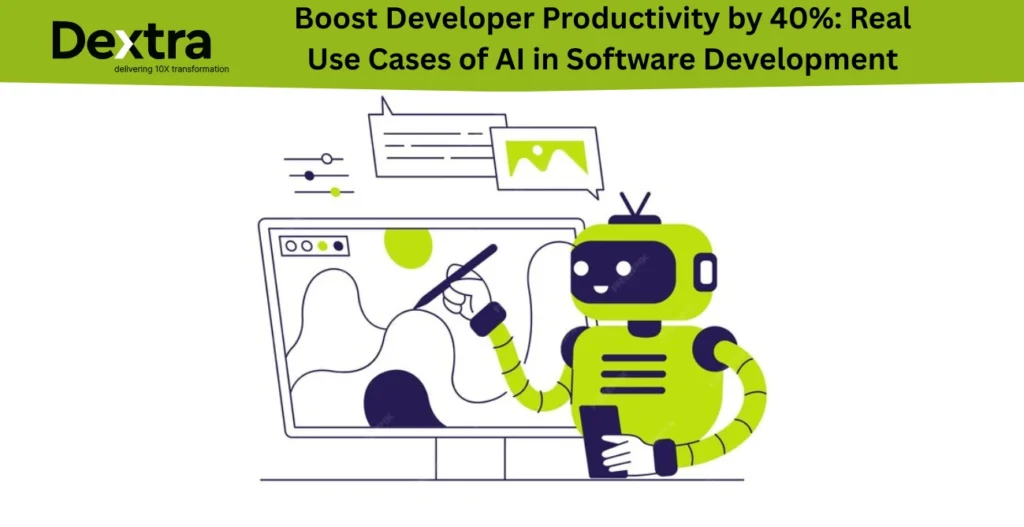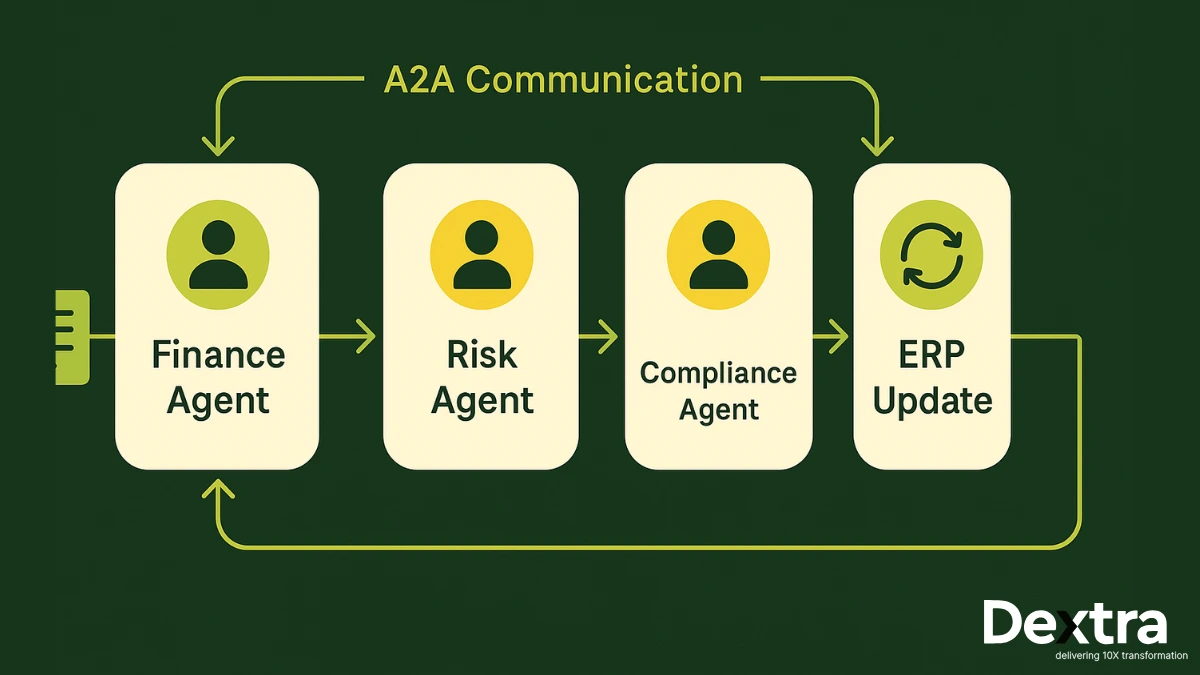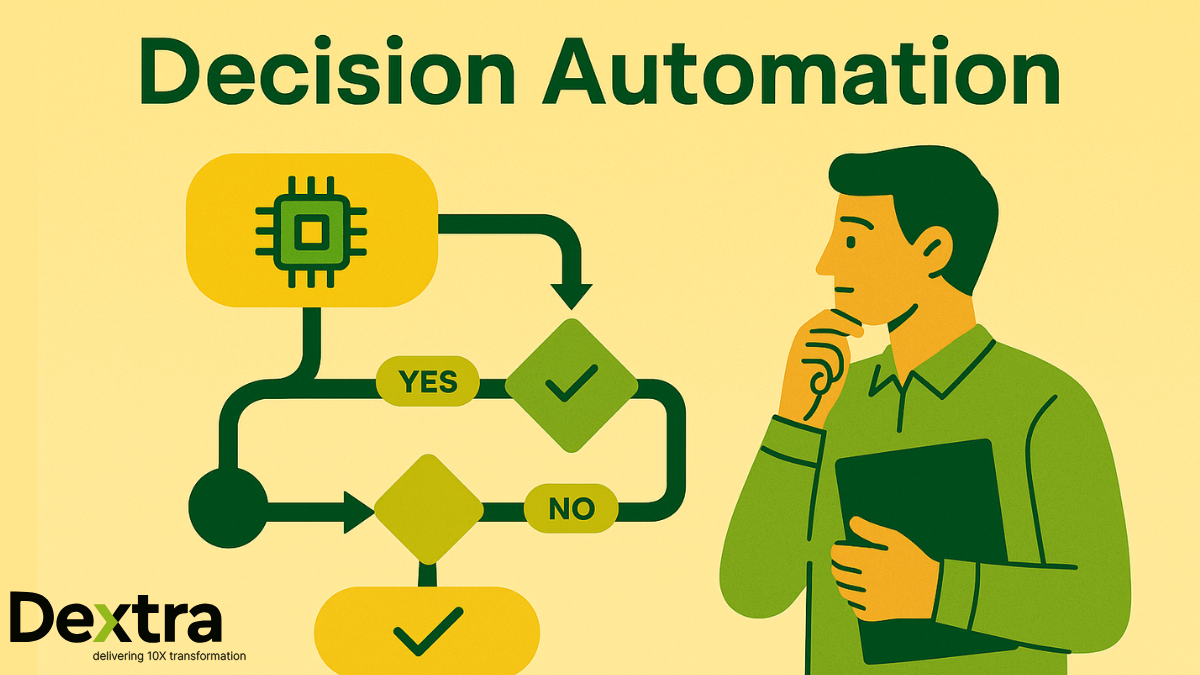Today’s development teams are under pressure to deliver faster, yet they still spend 30–40% of their time on repetitive coding tasks. While traditional tools aim to increase developer productivity, they often fall short when it comes to reducing real workload or accelerating output. If you’re wondering how to increase developer productivity in today’s fast-paced environment, the answer lies in generative AI. It transforms how developers work by automating repetitive processes, enhancing code quality, and speeding up delivery cycles.
As engineering teams across the USA, UAE, and Singapore embrace this shift, they’re starting to improve developer productivity in meaningful, measurable ways. As per a McKinseAs Study, software developers can complete a coding task in less than half time with the help of Generative AI.
At Dextralabs, we’re helping startups and scaling businesses tap into the true potential of AI in software development to not just work harder, but build smarter and faster.
Build faster, Ship smarter
Dextralabs helps dev teams unlock real productivity with Agentic AI.
Book your free AI productivity consultCommon Bottlenecks in Developer Productivity (SDLC)
Even the most skilled developers struggle to stay productive when common bottlenecks keep slowing down the workflow. Meaningful progress begins with recognizing and resolving these points of friction.
- Context Switching & Interruptions: Developers are often pulled between meetings, chats, and multiple tasks. This constant switching breaks concentration and reduces the quality of deep, focused coding time.
- Debugging and Code Refactoring Time: Fixing bugs and cleaning up old code takes up a large chunk of development hours often more than writing new features. Without the right tools, this becomes a slow, manual process.
- Legacy Systems & Technical Debt: Old, outdated systems and quick fixes from the past create technical debt that limits flexibility and slows down development. These systems often require extra effort just to maintain.
- Inadequate Documentation: Poor or missing documentation forces developers to dig through code to understand how things work, leading to wasted time and repeated mistakes.
- Poor Sprint Velocity: When bottlenecks pile up, sprint goals are missed, and momentum drops. This hurts team morale and delays product delivery.
- Library and Version Upgrades: Keeping up with dependency updates is time-consuming and risky. Even minor version changes can introduce bugs or break functionality if not managed properly.
How AI Supercharges Developer Productivity?
AI is no longer just a buzzword, it’s a practical solution reshaping how developers work. Teams may now deliver more quickly and effectively than ever before because of AI’s ability to automate repetitive processes and improve code quality.
Automated Code Generation
Tools like GitHub Copilot, Cody, Fine AI, and Tabnine help developers write code faster by suggesting entire blocks of logic in real time. This reduces the time spent on boilerplate code and accelerates development cycles.
Bug Detection and Auto-Fixes
AI-powered platforms can detect bugs as you code and even suggest instant fixes. This minimizes debugging time and ensures fewer issues reach production.
Automated Documentation Generation
Tools like Mintlify and Swimm turn your code into clear, readable documentation without manual effort. This improves knowledge sharing and reduces onboarding time.
Intelligent Code Reviews
AI reviews code changes and flags potential issues or improvements, helping maintain consistency and code quality even with large teams or tight deadlines.
AI-assisted testing and CI/CD
AI tools like Testim and QA Wolf generate test cases, automate QA, and streamline CI/CD processes, making releases faster and more reliable.
Smart Search Across Codebases
AI-driven search understands code structure and context, allowing developers to quickly find functions, variables, or references across even the largest codebases.
Real Use Cases from Dextralabs’ Clients
At Dextralabs, we don’t just talk about boosting productivity; we deliver it. Across the globe, our clients are using AI in software development to streamline workflows, reduce manual effort, and improve developer productivity in measurable ways. Here are a few real examples of how this transformation looks in action:
USA Fintech Startup: 42% Increase in Dev Velocity with AI-Assisted Sprint Planning
A fast-growing fintech company in New York wanted to accelerate product development within its Scrum framework. By using AI-assisted sprint planning, they automated backlog prioritization and task estimation. This strategic integration significantly boosted development speed and team alignment.
Challenge: Manual sprint planning slowed product development.
Solution: Integrated AI to analyze past sprints, estimate complexity, and prioritize backlog.
Results:
- 42% increase in sprint velocity (story points completed)
- Faster MVP delivery and adaptation to market changes
- Improved collaboration and stakeholder alignment
UAE E-commerce Platform: Reduced Bug-Fixing Time by 60% Using Gen AI Tools
One of the UAE’s top e-commerce platforms faced delays due to slow and manual bug resolution. To improve efficiency, they implemented generative AI tools that scanned code, flagged bugs, and recommended fixes instantly. This change drastically cut down bug-fixing time and improved release reliability.
Challenge: Bug identification and resolution was slow and error-prone.
Solution: Used AI to auto-detect code anomalies and suggest fixes in real-time.
Results:
- 60% faster bug resolution
- More frequent, reliable updates
- Reduced manual errors and customer complaints
Singapore SaaS Company: AI-Driven Productivity and Automation
A Singapore-based SaaS provider aimed to streamline operations and reduce manual workload. The company implemented AI-powered automation in data processing, software testing, and customer service. Lower operating costs, better product quality, and quicker releases were the results of this.
Challenge: Repetitive tasks and fragmented testing slowed growth.
Solution: Deployed AI for automation in customer service, analytics, and software testing.
Results:
- Faster release cycles and improved product quality
- Reduced operational costs
- Higher customer satisfaction and retention
India-Based Remote Team: 3x Faster Releases with AI-Driven CI/CD
A remote product team in India, working with a US-based enterprise, partnered with Dextralabs to enhance their CI/CD pipeline. Their goal: accelerate release cycles without compromising stability.
Challenge: Slow deployment cycles and integration issues hampered delivery speed.
Solution: Integrated AI-powered tools for automated testing, issue detection, and smart deployment within the CI/CD workflow.
Results:
- 3x faster release cycles
- Fewer post-deployment bugs
- Streamlined collaboration across time zones
Dextralabs’ Framework for AI-Powered Development
Adopting AI isn’t just about choosing the right tools, it’s about integrating them into your team’s workflow in a way that drives measurable impact. At Dextralabs, we follow a structured, hands-on approach to ensure successful AI adoption for dev teams. That’s how you increase developer productivity and deliver measurable ROI.
Here are our practical strategies for integrating AI into the software development lifecycle (SDLC):
Assessment of Current Tech Stack & Workflows
We begin with a deep dive into your existing infrastructure such as frameworks, languages, team size, and challenges. This helps us identify areas where AI can deliver the most value.
Mapping Tools to Developer Workflow
Next, we align the best AI software development tools with your daily processes be it coding, testing, documentation, or deployment. This ensures smooth integration without disrupting existing productivity.
Custom Training on Gen AI Best Practices
To maximize ROI, we provide tailored training sessions to upskill your developers. From ethical AI usage to writing effective prompts, we equip your team to make the most of generative AI.
Implementation + Testing Support
We don’t just recommend tools, we help you implement and test them in real-time projects. Our team ensures seamless onboarding and addresses any integration issues along the way.
Tracking Productivity Improvements (Quantitative Metrics)
Finally, we measure impact using metrics like cycle time, bug rates, deployment frequency, and code review efficiency. This allows you to see the ROI of your AI investment.
Best Generative AI Tools for Developer Productivity (2025 Edition)
In 2025, AI will continue to revolutionize the way developers work by automating routine tasks, improving code quality, and speeding up development cycles. These are carefully selected tools to increase developer productivity, depending on your goals and workflow needs.
| Use Case | Best Tools |
| Code Generation | GitHub Copilot, Cursor AI, Fine AI, Replit AI, CodeWhisperer |
| Bug Detection | DeepCode, Sonarqube AI, Snyk AI |
| Auto Testing | Testim, QA Wolf |
| Documentation | Mintlify, Swimm, Codeium |
| CI/CD | Harness, Codemagic (with AI add-ons) |
How Much Can You Boost Productivity?
The results are real. Generative AI can increase developer productivity by 20–40% on average. From faster code delivery to fewer bugs in production, teams see speed and quality improvements when AI is implemented thoughtfully. As per GitHub research, 97% of software developers are already using AI tools in their daily DevOps tasks.
However, the actual impact varies. Key factors include:
- Codebase complexity: Simpler projects see faster gains, while older or poorly documented code may take more setup.
- Team size and structure: Cross-functional teams or remote squads often benefit more from AI-driven collaboration tools.
- Tool adoption and usage depth: The more consistently AI tools are used across workflows, the greater the returns.
At Dextralabs, we measure success using concrete metrics like:
- Sprint velocity
- Cycle time
- Bug resolution rates
- Deployment frequency
- Developer satisfaction
This data-driven approach ensures you’re not just using AI; you’re also growing with it by focusing on how to increase developer productivity across every phase of development.
How to Get Started With AI in Your Dev Team?
Getting started with AI in software development doesn’t require overhauling everything overnight. Like any successful migration or improvement process, it’s about designing a phased, structured approach — ideally led by smart use of Large Language Models (LLMs). Here’s a proven way to boost developer productivity with an AI-first mindset:

Audit Developer Workflows Like a Migration Pipeline
Begin by treating your team’s current workflows — coding, debugging, testing, and documentation — like files moving through a migration pipeline. Identify where most bottlenecks happen. These pain points become the first candidates for AI assistance, just like identifying complex test files for LLM migration.
Break the workflows into discrete, trackable steps (e.g., code writing ➔ review ➔ bug fixing ➔ testing ➔ deployment). This modular view will help you introduce AI at specific checkpoints, making the integration more effective and measurable.
Choose AI Tools That Fit Your Stack — With Retry and Scaling in Mind
When choosing AI tools (whether for code generation, CI/CD automation, or intelligent testing), ensure they integrate well with your existing tech stack and developer flow.
Think of this as building an LLM-driven migration system: tools should allow retry loops (e.g., re-suggesting solutions until validation passes) and dynamic adaptability (e.g., updating suggestions based on feedback/errors). Tools that can scale across projects and retry intelligently will drive better productivity gains.
Establish Clear AI Usage Policies — Think Step Validation
Successful LLM migrations rely on clear validation steps. Similarly, before rolling out AI tools across your dev team, create internal policies defining:
- Where and how AI can be used (e.g., code snippets, documentation, test writing)
- How to validate AI outputs (manual review, automated testing)
- Ownership and responsibility (who owns AI-generated code?)
- Data privacy and compliance (especially important if tools interact with proprietary code)
Establishing a “validation and promotion” system — where outputs must pass a set of standards before being merged — ensures AI use remains structured and safe.
Train Developers on Secure, Ethical, and Context-Rich AI Use
Just like complex LLM migrations require feeding models detailed project-specific context for better results, your developers need training on how to get the best out of AI.
Focus on:
- Ethical use (e.g., checking licensing of AI-generated suggestions)
- Security protocols (e.g., not leaking sensitive codebases into public AI tools)
- Effective prompting (teaching developers to write rich, contextual prompts that yield better outputs)
- Human-in-the-loop mindset (AI assists, but humans validate and refine)
Embedding these skills ensures the team treats AI as a partner, not an unchecked code generator.
Build Feedback Loops to Improve Continuously
Finally, treat AI adoption like an ongoing migration: track usage patterns, failure points, and success stories. Analyze where AI tools succeed, where they need retraining (prompt tuning), and where manual intervention is still required.
Implement a system similar to “sample, tune, sweep”:
- Sample failing cases
- Tune the usage policies, tools, or prompts
- Sweep across the team to improve outcomes
Over time, this method will refine how your developers use AI, driving better productivity while keeping quality and security intact. Applying an LLM migration mindset to developer productivity — modular steps, validation pipelines, retries, dynamic prompts, and context amplification — allows your team to introduce AI safely, scalably, and effectively.
Train Developers on Ethical + Secure AI Use
Equip your team with best practices for using AI responsibly covering areas like licensing, data privacy, and prompt writing for better results.
Not sure where to begin with AI in your development process? Let Dextralabs guide you. We offer free AI consultation where our experts will assess your current workflows, identify key productivity blockers, and recommend a tailored AI adoption strategy designed to help your team build faster, smarter, and more efficiently.
Final Thoughts
Software development is being revolutionized by generative AI, which speeds up delivery, improves code quality, and automates repetitive operations. At Dextralabs, an AI software development company in USA, we help teams harness AI not just to work faster, but smarter and unlock real productivity gains of up to 40%. With the right tools, training, and a clear strategy, your dev team can reduce bottlenecks, ship faster, and maintain high-quality code. Whether you’re a startup or scaling a business. Let Dextra Labs help you turn potential into performance with a free AI productivity consultation tailored to your tech stack and goals.
Ready to boost your dev team’s productivity?
Dextralabs shows you how AI can elevate your tech team’s efficiency.
Book your free AI productivity consultFAQ’s:
Q. What is the responsibility of developers using generative AI?
Developers using generative AI must ensure their code is original, respects open-source licenses, and maintains data privacy. They must avoid plagiarism and comprehend the source and implications of AI-generated code in order to use it ethically.
Q. How can generative AI help in software development?
Generative AI assists developers by speeding up code writing, detecting bugs early, and automating testing. With less manual effort, this results in quicker development cycles and better code quality.
Q. How to use AI in software development?
To use AI effectively, developers can integrate tools like GitHub Copilot, QA Wolf, or CodeWhisperer into their IDEs, CI/CD pipelines, and issue-tracking systems. These technologies increase efficiency by integrating easily into regular workflows.
Q. Will AI replace developers?
AI will not replace developers, it’s designed to assist them. While it can handle repetitive tasks, human oversight, creativity, and problem-solving remain irreplaceable in the development process.
Q. What is AI software development?
AI software development involves using intelligent tools to automate and optimize coding, testing, and deployment tasks. It improves the speed, intelligence, and efficiency of the entire software development process.
Q. How does Gen AI improve software development?
Generative AI improves software development by reducing manual workload, increasing speed, and minimizing errors. This speeds up the production of high-quality software while allowing developers to concentrate on addressing challenging issues.








